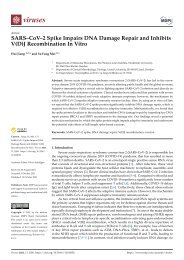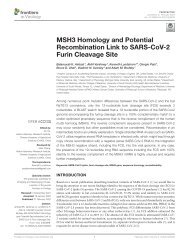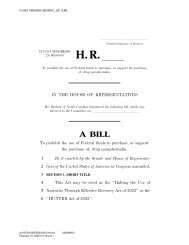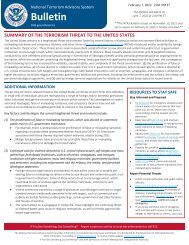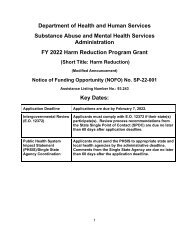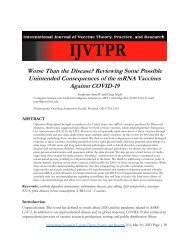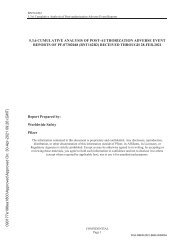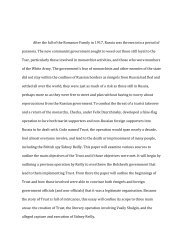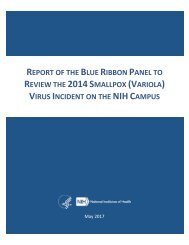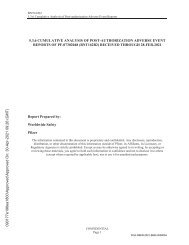A Literature Review and Meta Analysis of the Effects of Lockdowns on COVID 19 Mortality
Create successful ePaper yourself
Turn your PDF publications into a flip-book with our unique Google optimized e-Paper software.
<str<strong>on</strong>g>the</str<strong>on</strong>g> effect <str<strong>on</strong>g>of</str<strong>on</strong>g> lockdowns in <str<strong>on</strong>g>the</str<strong>on</strong>g>se studies might c<strong>on</strong>tain time-dependent shifts, such as seas<strong>on</strong>ality.<br />
This excludes studies like Bakolis et al. (2021) <str<strong>on</strong>g>and</str<strong>on</strong>g> Siedner et al. (2020).<br />
Given our criteria, we exclude <str<strong>on</strong>g>the</str<strong>on</strong>g> much-cited paper by Flaxman et al. (2020), which claimed<br />
that lockdowns saved three milli<strong>on</strong> lives in Europe. Flaxman et al. assume that <str<strong>on</strong>g>the</str<strong>on</strong>g> p<str<strong>on</strong>g>and</str<strong>on</strong>g>emic<br />
would follow an epidemiological curve unless countries locked down. However, this assumpti<strong>on</strong><br />
means that <str<strong>on</strong>g>the</str<strong>on</strong>g> <strong>on</strong>ly interpretati<strong>on</strong> possible for <str<strong>on</strong>g>the</str<strong>on</strong>g> empirical results is that lockdowns are <str<strong>on</strong>g>the</str<strong>on</strong>g> <strong>on</strong>ly<br />
thing that matters, even if o<str<strong>on</strong>g>the</str<strong>on</strong>g>r factors like seas<strong>on</strong>, behavior etc. caused <str<strong>on</strong>g>the</str<strong>on</strong>g> observed change in<br />
<str<strong>on</strong>g>the</str<strong>on</strong>g> reproducti<strong>on</strong> rate, Rt. Flaxman et al. are aware <str<strong>on</strong>g>of</str<strong>on</strong>g> this <str<strong>on</strong>g>and</str<strong>on</strong>g> state that “our parametric form <str<strong>on</strong>g>of</str<strong>on</strong>g><br />
Rt assumes that changes in Rt are an immediate resp<strong>on</strong>se to interventi<strong>on</strong>s ra<str<strong>on</strong>g>the</str<strong>on</strong>g>r than gradual<br />
changes in behavior.” Flaxman et al. illustrate how problematic it is to force data to fit a certain<br />
model if you want to infer <str<strong>on</strong>g>the</str<strong>on</strong>g> effect <str<strong>on</strong>g>of</str<strong>on</strong>g> lockdowns <strong>on</strong> <strong>COVID</strong>-<strong>19</strong> mortality. 16<br />
The counterfactual difference-in-difference studies in this review generally exploit variati<strong>on</strong><br />
across countries, U.S. states, or o<str<strong>on</strong>g>the</str<strong>on</strong>g>r geographical jurisdicti<strong>on</strong>s to infer <str<strong>on</strong>g>the</str<strong>on</strong>g> effect <str<strong>on</strong>g>of</str<strong>on</strong>g> lockdowns<br />
<strong>on</strong> <strong>COVID</strong>-<strong>19</strong> fatalities. Preferably, <str<strong>on</strong>g>the</str<strong>on</strong>g> effect <str<strong>on</strong>g>of</str<strong>on</strong>g> lockdowns should be tested using r<str<strong>on</strong>g>and</str<strong>on</strong>g>omized<br />
c<strong>on</strong>trol trials, natural experiments, or <str<strong>on</strong>g>the</str<strong>on</strong>g> like. However, <str<strong>on</strong>g>the</str<strong>on</strong>g>re are very few studies <str<strong>on</strong>g>of</str<strong>on</strong>g> this type. 17<br />
Syn<str<strong>on</strong>g>the</str<strong>on</strong>g>tic c<strong>on</strong>trol studies<br />
The syn<str<strong>on</strong>g>the</str<strong>on</strong>g>tic c<strong>on</strong>trol method is a statistical method used to evaluate <str<strong>on</strong>g>the</str<strong>on</strong>g> effect <str<strong>on</strong>g>of</str<strong>on</strong>g> an interventi<strong>on</strong><br />
in comparative case studies. It involves <str<strong>on</strong>g>the</str<strong>on</strong>g> c<strong>on</strong>structi<strong>on</strong> <str<strong>on</strong>g>of</str<strong>on</strong>g> a syn<str<strong>on</strong>g>the</str<strong>on</strong>g>tic c<strong>on</strong>trol which functi<strong>on</strong>s as<br />
<str<strong>on</strong>g>the</str<strong>on</strong>g> counter factual <str<strong>on</strong>g>and</str<strong>on</strong>g> is c<strong>on</strong>structed as an (optimal) weighted combinati<strong>on</strong> <str<strong>on</strong>g>of</str<strong>on</strong>g> a pool <str<strong>on</strong>g>of</str<strong>on</strong>g> d<strong>on</strong>ors.<br />
For example, Born et al. (2021) create a syn<str<strong>on</strong>g>the</str<strong>on</strong>g>tic c<strong>on</strong>trol for Sweden which c<strong>on</strong>sists <str<strong>on</strong>g>of</str<strong>on</strong>g> 30.0%<br />
Denmark, 25.3% Finl<str<strong>on</strong>g>and</str<strong>on</strong>g>, 25.8% Ne<str<strong>on</strong>g>the</str<strong>on</strong>g>rl<str<strong>on</strong>g>and</str<strong>on</strong>g>s, 15.0% Norway, <str<strong>on</strong>g>and</str<strong>on</strong>g> 3.9% Sweden. The effect <str<strong>on</strong>g>of</str<strong>on</strong>g><br />
<str<strong>on</strong>g>the</str<strong>on</strong>g> interventi<strong>on</strong> is derived by comparing <str<strong>on</strong>g>the</str<strong>on</strong>g> actual developments to those c<strong>on</strong>tained in <str<strong>on</strong>g>the</str<strong>on</strong>g><br />
syn<str<strong>on</strong>g>the</str<strong>on</strong>g>tic c<strong>on</strong>trol.<br />
We exclude syn<str<strong>on</strong>g>the</str<strong>on</strong>g>tic c<strong>on</strong>trol studies because <str<strong>on</strong>g>of</str<strong>on</strong>g> <str<strong>on</strong>g>the</str<strong>on</strong>g>ir inherent empirical problems as discussed<br />
by Bjørnskov (2021b). He finds that <str<strong>on</strong>g>the</str<strong>on</strong>g> syn<str<strong>on</strong>g>the</str<strong>on</strong>g>tic c<strong>on</strong>trol versi<strong>on</strong> <str<strong>on</strong>g>of</str<strong>on</strong>g> Sweden in Born et al. (2021)<br />
deviates substantially from “actual Sweden,” when looking at <str<strong>on</strong>g>the</str<strong>on</strong>g> period before mid-March 2020,<br />
when Sweden decided not to lock down. Bjørnskov estimates that actual Sweden experienced<br />
16<br />
Several scholars have criticized Flaxman et al. (2020), e.g. see Homburg <str<strong>on</strong>g>and</str<strong>on</strong>g> Kuhb<str<strong>on</strong>g>and</str<strong>on</strong>g>ner (2020), Lewis (2020),<br />
<str<strong>on</strong>g>and</str<strong>on</strong>g> Lemoine (2020).<br />
17<br />
Kepp <str<strong>on</strong>g>and</str<strong>on</strong>g> Bjørnskov (2021) is <strong>on</strong>e such study. They use evidence from a quasi-natural experiment in <str<strong>on</strong>g>the</str<strong>on</strong>g> Danish<br />
regi<strong>on</strong> <str<strong>on</strong>g>of</str<strong>on</strong>g> Nor<str<strong>on</strong>g>the</str<strong>on</strong>g>rn Jutl<str<strong>on</strong>g>and</str<strong>on</strong>g>. After <str<strong>on</strong>g>the</str<strong>on</strong>g> discovery <str<strong>on</strong>g>of</str<strong>on</strong>g> mutati<strong>on</strong>s <str<strong>on</strong>g>of</str<strong>on</strong>g> Sars-CoV-2 in mink – a major Danish export –<br />
seven <str<strong>on</strong>g>of</str<strong>on</strong>g> <str<strong>on</strong>g>the</str<strong>on</strong>g> 11 municipalities <str<strong>on</strong>g>of</str<strong>on</strong>g> <str<strong>on</strong>g>the</str<strong>on</strong>g> regi<strong>on</strong> went into extreme lockdown in early November, while <str<strong>on</strong>g>the</str<strong>on</strong>g> four o<str<strong>on</strong>g>the</str<strong>on</strong>g>r<br />
municipalities retained <str<strong>on</strong>g>the</str<strong>on</strong>g> moderate restricti<strong>on</strong>s <str<strong>on</strong>g>of</str<strong>on</strong>g> <str<strong>on</strong>g>the</str<strong>on</strong>g> remaining country. Their analysis shows that while<br />
infecti<strong>on</strong> levels decreased, <str<strong>on</strong>g>the</str<strong>on</strong>g>y did so before lockdown was in effect, <str<strong>on</strong>g>and</str<strong>on</strong>g> infecti<strong>on</strong> numbers also decreased in<br />
neighbor municipalities without m<str<strong>on</strong>g>and</str<strong>on</strong>g>ates. They c<strong>on</strong>clude that efficient infecti<strong>on</strong> surveillance <str<strong>on</strong>g>and</str<strong>on</strong>g> voluntary<br />
compliance make full lockdowns unnecessary, at least in some circumstances. Kepp <str<strong>on</strong>g>and</str<strong>on</strong>g> Bjørnskov (2021) is not<br />
included in our review, because <str<strong>on</strong>g>the</str<strong>on</strong>g>y focus <strong>on</strong> cases <str<strong>on</strong>g>and</str<strong>on</strong>g> not <strong>COVID</strong>-<strong>19</strong> mortality. Dave et al. (2020) is ano<str<strong>on</strong>g>the</str<strong>on</strong>g>r<br />
such study. They see <str<strong>on</strong>g>the</str<strong>on</strong>g> Wisc<strong>on</strong>sin Supreme Court abolishment <str<strong>on</strong>g>of</str<strong>on</strong>g> Wisc<strong>on</strong>sin’s “Safer at Home” order (a SIPO)<br />
as a natural experiment <str<strong>on</strong>g>and</str<strong>on</strong>g> find that “<str<strong>on</strong>g>the</str<strong>on</strong>g> repeal <str<strong>on</strong>g>of</str<strong>on</strong>g> <str<strong>on</strong>g>the</str<strong>on</strong>g> state SIPO impacted social distancing, <strong>COVID</strong>-<strong>19</strong> cases, or<br />
<strong>COVID</strong>-<strong>19</strong>-related mortality during <str<strong>on</strong>g>the</str<strong>on</strong>g> fortnight following enactment.” Dave et al. (2020) is not included in our<br />
review, because <str<strong>on</strong>g>the</str<strong>on</strong>g>y use a syn<str<strong>on</strong>g>the</str<strong>on</strong>g>tic c<strong>on</strong>trol method.<br />
9




